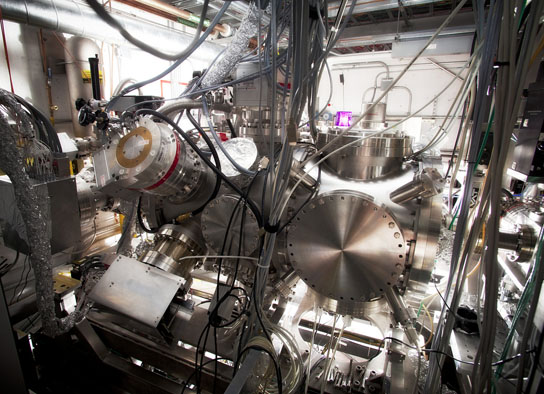The realm of atomic and subatomic physics is replete with intriguing phenomena that challenge our conventional understanding of light and matter. Among these phenomena, artificial atoms have emerged as titans not just in stature but in their extraordinary capacity to manipulate light at unprecedented scales. These artificial constructs, often engineered at the nanoscale, promise to revolutionize a plethora of fields ranging from telecommunications to biomedical applications. The array of functionalities they present is striking, raising the question: how can these minuscule titans supercharge light?
To navigate this discussion, it is essential first to comprehend the foundational concepts underlying artificial atoms. Artificial atoms can be construed as quantum dots or other nanoscale structures that exhibit discrete energy levels analogous to those of natural atoms. Their synthesis involves sophisticated techniques like epitaxial growth, where layers of semiconductor material are meticulously deposited. These structures typically consist of a handful of atoms and are designed to trap excitons—bound states of electrons and holes—at their core. Thus, the fundamental attributes reminiscent of natural atoms are effectively replicated, setting the stage for remarkable optical phenomena.
At the heart of the allure of artificial atoms lies their ability to engage in photonic interactions that are both tunable and predictable. Unlike traditional optical materials, the emission and absorption spectra of these artificial entities can be finely adjusted by manipulating parameters such as size, shape, and composition. A prime example is the manipulation of quantum dots, where a mere alteration of a dot’s diameter can shift its color emission from the infrared to the visible spectrum. This tunability offers unparalleled versatility that can be harnessed for different technological applications, from solar cells to lasers.
One of the most captivating aspects of artificial atoms is their role in enhancing light-matter interactions. The principle of quantum confinement dictates that as the dimensions of a particle decrease, its energy levels become quantized, leading to a pronounced increase in the interaction strength with incoming light. This phenomenon serves as a springboard for myriad applications, particularly in the domain of photonics. As such, artificial atoms can act as resonant cavities for photons, facilitating phenomena such as enhanced spontaneous emission and nonlinear optical effects. In this manner, they have been likened to tiny titans, embodying a potent interplay of quantum mechanics and classical optics.
The phenomenon known as “superradiance” further exemplifies the capabilities of these artificial constructs. In this context, when a collection of artificial atoms is excited, they can collectively emit light in a coherent manner, dramatically amplifying the emitted intensity. Researchers have harnessed this phenomenon to design more efficient light-emitting devices, which heralds a new epoch in energy-efficient lighting and laser technology. Such coherent light sources could transform communication technologies, enabling faster data transmission rates that current systems cannot achieve.
Moreover, the interplay between artificial atoms and surface plasmons—a collective oscillation of electrons at the surface of a conductor—holds promise for further advancements. When light interacts with these nanoscale structures, it has the potential to excite surface plasmons, leading to localized electromagnetic fields that can dramatically enhance light absorption and emission. This symbiotic relationship not only augments the capability of artificial atoms but also fosters innovations in biosensing and imaging technologies. Consequently, the fusion of artificial atoms with plasmonic structures embodies a confluence of two titanic forces with the capacity for transformative applications.
Looking to the future, the implications of harnessing artificial atoms stretch far beyond mere optical enhancements. Their integration into quantum computing paradigms presents an exciting frontier. The discrete energy levels that characterize artificial atoms make them ideal candidates for qubits— the building blocks of quantum computers. By utilizing these tiny titans, researchers can explore quantum superposition and entanglement, unlocking computational capabilities beyond the limits of classical systems. Such advancements could facilitate breakthroughs in fields from material science to cryptography, fundamentally altering our approach to problem-solving in the digital age.
Nonetheless, the venture into the domain of artificial atoms is not without challenges. The scalability of synthesis techniques, as well as the reproducibility of desired properties, poses significant hurdles in transitioning from laboratory settings to practical applications. As research progresses, techniques for large-scale fabrication and integration into existing technologies will be paramount. To overcome these obstacles will require interdisciplinary collaboration across physics, material science, and engineering.
In conclusion, artificial atoms represent a burgeoning field with immense potential. As tiny titans poised to supercharge light, they bridge the gap between quantum mechanics and classical optics, yielding novel applications that were once confined to the realm of theoretical exploration. The continued investigation of these constructs promises not only to expand our understanding of the fundamental properties of light and matter but also to propel innovative technologies that could redefine the landscape of numerous industries. The quest for knowledge in this domain is not solely an academic pursuit; it is a vital component of humanity’s ongoing aspiration to harness the subtleties of nature for the benefit of society. As researchers continue to unravel the complexities of these artificial constructs, we stand on the precipice of a technological renaissance facilitated by the manipulation of light at the atomic level.












